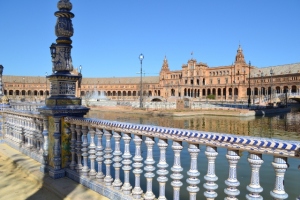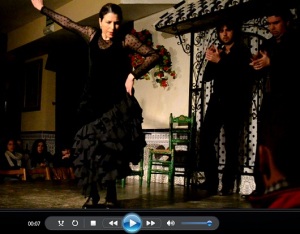We chose to take an early morning train from Granada to Sevilla so that we could check out some of the Andalusian landscape along the way. Much to our surprise, seemingly all we saw from the train windows were endless rolling hills covered with olives trees. We had been offered olives with pretty much every meal since arriving in Spain, but hadn’t really connected the dots. Did you know that Spain is the world’s largest producer of olives?!
After arriving in Sevilla, we met up with some friends who are living there as English teachers. It was fun to connect with people we know after nearly a month of solo traveling. No, we’re not sick of each other, but a familiar face always has a way of making you feel at home.
Our main mode of transport while in Sevilla was bikes, via a bike share program called Sevici (for all you Denver people, it’s similar to B-Cycle). Thanks to Blake and Danielle, we were able to use the bikes for free!
Riding around allowed us to cover much of the city in just a couple of days. A few of our favorite sites were the Plaza de España & Catedral de Sevilla, and we also enjoyed exploring the neighborhoods of Alameda, Santa Cruz and Triana.

La Plaza de España was built in 1928 for a world’s fair. It is surrounded by the beautiful Parque de María Luisa.
Our nights in Sevilla were filled with tapas and flamenco. El Ambigú, which was recommended by Amy’s sister, Jennifer, was a casual place filled with locals and serving delicious tapas (you can read our TripAdvisor review here). Another great tapas place we found for a late night snack was El Rinconcillo, founded in 1670, and in operation ever since.
Flamenco is part of the soul of Sevilla and can be seen everywhere; whether it be a flamenco school, a store selling traditional dresses, posters promoting upcoming shows, or an actual Tabalo.
Our first flamenco experience was a performance held at La Carboneria, a flamenco venue in the Santa Cruz neighborhood that offers complimentary shows each night. This venue features ample seating, a fun bar and a casual setting. The show had no dancing, but highlighted the classic cante (singing), toque (guitar) and palmas (handclaps). It was very different but equally as impressive as the second, full blown performance that we attended the following night.
The second flamenco show, held at La Peña Flamenca Torres Macarena, was a much more intimate setting, with a raised stage and a few rows of seating on three sides. We were impressed by the dancer’s intense focus and incredible tranquil speed. Additionally, this show featured two singers which gave the performance a much more robust sound. In hopes of capturing the complex auditory component of flamenco, in addition to photos, we also took a short video which you can watch by clicking on the picture below.
After just under a week in Sevilla, we both agreed to add it to our shortlist of places we would consider living in the future. If you plan on visiting Spain, do not miss this city!







¿Y cuál palo es?
Pan, pan pan, morcilla…morcilla